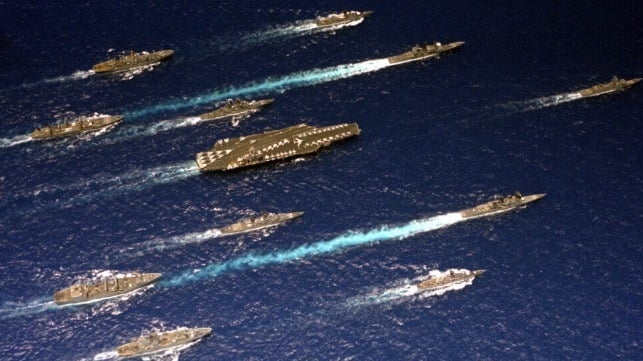Op-Ed: The U.S. Navy Needs an Operational Level of War Strategy

[By Dr. Steven Wills]
This article appears courtesy of CIMSEC's Notes to the New Chief of Naval Operations Series and may be found in its original form here.
The United States Navy has been without an operational level of war strategy to guide its force size, design, and employment since June 1990. In testimony to the Senate Armed Services Committee, Chief of Naval Operations (CNO) nominee Admiral Frank Kelso put the Maritime Strategy of the 1980s “on the shelf,” stating, “military strategy needs a specific enemy, and the issues before us today seem ones of naval policy rather than strategy.” Since Admiral Kelso’s CNO tenure, the Navy has created a series of white papers and policy documents. These ranged from Kelso’s “From the Sea” document of 1992, to the most recent “Advantage at Sea, Tri-Service Maritime Strategy” signed by CNO Admiral Mike Gilday in 2020. CNOs have also issued guidance to the force, with recent examples including CNO Admiral Richardson’s “Designs for Maritime Superiority,” and Admiral Gilday’s “Navigation Plans.” But these documents have not sought to provide a concrete operational strategy for how the Navy would be employed in war.
The same period highlighted how the lack of an operational strategy contributed to the Navy’s declining force structure and readiness. From 1990 to 2020, the Navy decreased from over 520 ships to less than 300. Yet the service continued to forward deploy an average of 100 ships while at the same time maintaining a potential “surge” capacity for short-notice deployment of six carrier strike groups, such as were surged for Operations Desert Storm, and later Operations Enduring and Iraqi Freedom. These requirements became a heavy burden on fleet readiness over the 2000s and 2010s. Successive reports from the Board of Inspection and Survey, the Government Accountability Office, the Congressional Budget Office and Congressional Research Services, and others have been critical of Navy readiness. The 2010 Balisle report and Center for Naval Analyses “Tipping Point” studies both sounded significant alarms on Navy readiness challenges.
Successive service plans to address readiness problems in the form of the Fleet Response Plan, Optimized Fleet Response Plan, and now the 75 Ready Ships initiative have all failed to address the root causes of declining Navy readiness. Multiple classes of ships are reaching block obsolescence, including the CG-47 class cruiser, the LSD-41 class amphibious warfare ship, the SSN-688 class submarine, and the first units of the DDG-51 class destroyer. Attempts in the past two decades to create a new generation of surface ships such as the Zumwalt-class destroyer and littoral combat ship (LCS) failed to provide the desired capability. It seems clear that without an operational strategy to anchor its focus, the U.S. Navy has been unable to develop and sustain a force design with specific numbers of ships that meet its global mission set.
Some may argue that an operational level of war strategy is not the purview of the Navy as a service, but rather that of the combatant commands. The recent Marine Corps reforms highlight what is possible. The development of operational warfighting concepts such as stand-in forces and expeditionary advanced base operations (EABO) set the stage for changes to force design and how to measure readiness. By changing the forces that the service provides, the Marine Corps was able to subsequently evolve the warfighting options and strategies of the combatant commanders.
The 1986 Goldwater-Nichols Act instituted a bifurcation between the military entities that generate forces and those that employ them, which seemingly put a service-developed operational strategy like the Navy’s 1980s Maritime Strategy out of reach. But this bifurcation does not absolve the services of the fundamental need to develop warfighting strategies. The services must develop their own separate visions of future warfighting given how their force design and readiness mandates go well beyond the typical time horizon of combatant commander responsibilities.
The U.S. Navy is now at a force design and readiness crisis point not seen since Admiral Elmo Zumwalt took the helm in 1970. Admiral Lisa Franchetti should take the initiative to develop a comprehensive, operational level of war maritime strategy that will determine fleet missions, which will subsequently inform a specific fleet size and force design. Forging a stronger connection between warfighting strategy and force design will remain among the most pressing matters for the leadership of the United States Navy.
Dr. Steven Wills is a navalist for the Center for Maritime Strategy at the Navy League of the United States. He is an expert in U.S. Navy strategy and policy and U.S. Navy surface warfare programs and platforms. His research interests include the history of U.S. Navy strategy development over the Cold War and immediate, post-Cold War era, and the history of the post-World War II U.S. Navy surface fleet.
The opinions expressed herein are the author's and not necessarily those of The Maritime Executive.
